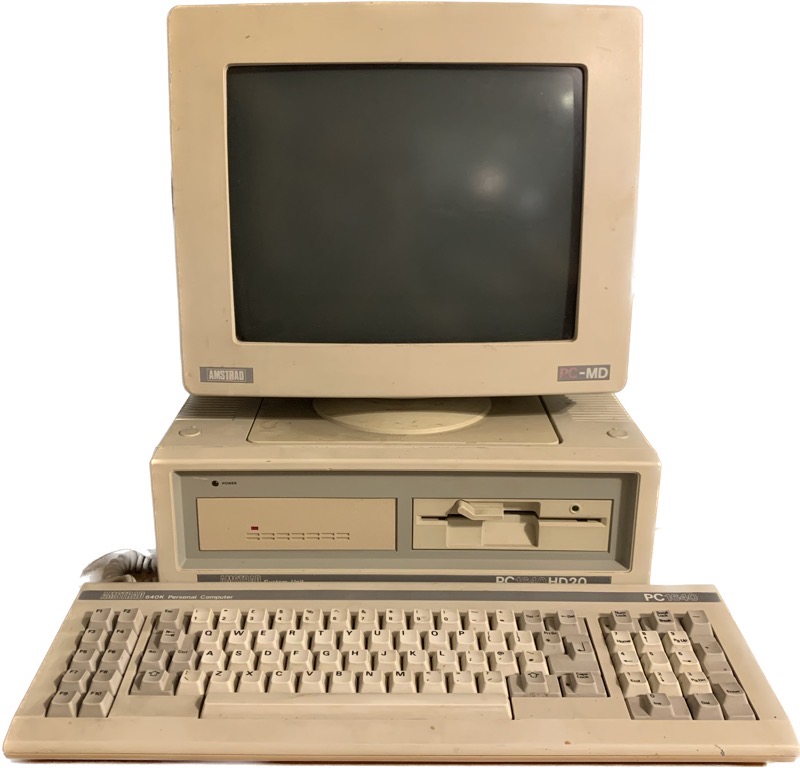
Some machines go beyond silicon, plastic, and steel. They represent time, place, and a memory. For me, the Amstrad PC1640 is one of those machines.
The PC of my childhood, I was recently lucky enough to (re)acquire one — decades after my original had been lost.
The Amstrad PC1640: A Snapshot of the Late 1980s
Launched in 1987, the Amstrad PC1640 was part of Amstrad’s push to bring IBM-compatible computing to the masses at an affordable price. With an Intel 8086 processor, support for up to 640KB RAM, and a choice of graphics standards (CGA, EGA, Hercules), the PC1640 was a versatile machine.
What really set Amstrad apart was its all-in-one philosophy. Instead of piecemeal components and high costs, the PC1640 came as a complete package: base unit, monitor, keyboard, and even software. For many families (including mine!), this was the first step into the world of the PC.
Amstrad PC1640 Specifications
| Component | Details |
| CPU | Intel 8086 @ 8 MHz |
| RAM | 640 KB |
| Graphics | Embedded Paradise chipset supporting CGA, Hercules (MDA), and EGA modes |
| Storage | 5.25” floppy drives (1 or 2), optional 20MB hard disk |
| Display | Choice of monochrome (PC-MD), colour CGA (PC-CD), or enhanced EGA (PC-ECD) monitors |
| Operating System | MS-DOS 3.2 (bundled) + GEM Desktop 3 GUI |
| Keyboard | Full-size Amstrad XT-style mechanical keyboard |
| Expansion | 4x 8-bit ISA slots (for additional cards and upgrades) |
Impact and Legacy
While Amstrad’s CPC range had already made a name in the home computer scene, the PC1640 was a different beast entirely. It wasn’t just for games or hobby projects — it was a serious PC compatible, capable of running DOS applications, business software, and the growing library of IBM PC games.
In the UK especially, the PC1640 helped democratise computing. Its affordability compared to IBM and Compaq systems meant more people could own a “proper” PC. Many took the leap, with the PC1640 and sister PC1512 model taking more than 30% of the PC market.
A Machine of Memories
For me, the PC1640 was a core memory of my childhood. It was the machine where I first cut my teeth on DOS commands, grappled with memory management — and of course spent endless hours with games that pushed the limits of the humble hardware.
Rediscovering the PC1640 now is pure nostalgia — like opening a time capsule. The satisfying clunkiness of the mouse buttons, the slightly off-spec keyboard, the forgotten familiarity of the various knobs and dials — all of them take me back. These small details remind me of a time when computing felt new, mysterious, and exciting.
Games to Try on the Amstrad PC1640
One of my joys when revisiting retro hardware is rediscovering the games that made it special. The PC1640’s 8086 CPU isn’t too beefy, but there’s a surprisingly rich library of classics. Here are some of my faves:
- Prince of Persia (1989) – Smooth animation and challenging platforming, even on an 8086.
- Commander Keen (1990) – A fun side-scrolling adventure that plays well in EGA mode.
- SimCity (1989) – The original city builder is perfectly at home on the PC1640.
- Alley Cat (1984) – A quirky and addictive early IBM PC classic that runs on even the most modest hardware.
- Monkey Island (1990) – Pushes the limits, but still playable on an 8086.
These titles capture the diversity of what the PC1640 could do: platformers, adventures, simulators, and arcade fun. They’re not just games, they’re part of the memory of what it meant to discover computing in the late 1980s.
Comments